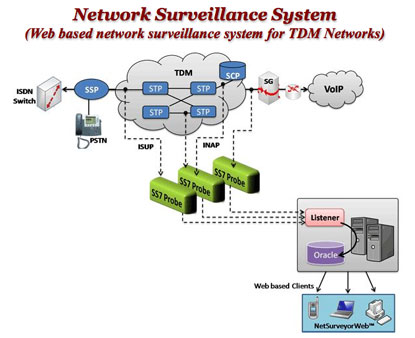A network operator, service provider, or equipment manufacturer must have the means to perform surveillance tasks remotely, automatically, and non-intrusively. Fortunately, the network backbone contains a wealth of information that can be monitored and collected to support these activities.
GL's TDM Network Monitoring System uses an open three tier distributed architecture driven by non-intrusive hardware probes, intelligent software, and a database engine. The architecture as shown in the graphic consists of a scalable and flexible system, so the user can use it for multiple sites and various applications.
T1/E1/T3/E3 Probes are deployed in the field to monitor various protocols and conditions which are then collected at a central site into a database. Data records are stored into a centralized database (Oracle) using ODBC. With the use of web server, the remote / local monitoring can be accessed using simple web browser interface such as SS7 / ISDN NetSurveyorWeb™ or NetSurveyorWeb™ for T1E1 Physical Layer.
Typical Applications:
- Call Detail Records, fraud detection and location, remote protocol analysis and troubleshooting, real-time signaling monitor, traffic optimization engineering, and statistics.
- Determine actual call signaling routes to verify network functionality under all situations including congestion and loss of SS7 nodes.
- Revenue and billing verification, alarm monitoring, intrusive testing.
- Quality of service measurements, call trace and recording.
Conventional Protocols:
- CAS (R1- now, R2 - future), SS7 ISUP/TUP (Different Variants), SS7 ANSI AIN.
- ISDN (4ESS, 5ESS, ITU, ETSI, BELLCORE, QSIG).
- GR303, V5.X, INAP CS1 & CS2, INAP+.
Protocols for Mobile Networks:
- IS41-C, GSM A and A-bis Interface, GPRS Gb, ETSI MAP.
Topical Tags :
Regional Tags :


